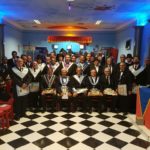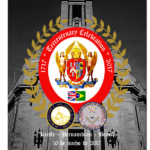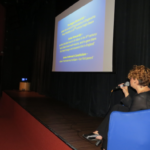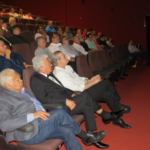We are absolutely delighted to announce to QCCC members that the Most Worshipful The Grand Master, His Royal Highness The Duke of Kent, KG, proposes to confer on Emeritus Professor Aubrey Newman, PJGD, the chairman of the editorial committee and a past master of QC, the Grand Master’s Order of Service to Masonry. It is intended that the order will be conferred by the Most Worshipful the Pro Grand Master at the Quarterly Communication of the United Grand Lodge of England on 13 September 2017.
The Order of Service to Masonry is the highest honour the Grand Master can confer on any member of the Craft. Instituted in 1945, it is in the personal gift of the Grand Master and is an acknowledgment of exceptional services to freemasonry. The Order is limited to 12 holders and entitles them to place the letters OSM after their names, preceding any other Masonic rank that they hold.
QC’s Lodge meeting on Thursday, 14 September 2017 (4.00 p.m. at FMH, Great Queen Street, London) will include the 2017 Prestonian Lecture: ‘The Grand Design’. The lecturer is Dr Jim Daniel. Jim has been a Freemason since 1961. Previously a cultural diplomat (1964-89), he is known best as the past Grand Secretary General of the Ancient and Accepted (‘Scottish’) Rite (1989-98), and past Grand Secretary of UGLE (1998-2002). Jim is a past master of QC and now an honorary member of the lodge. An exciting evening is guaranteed.
Jorge Alfredo Gavira-Lievano is back as a Local Secretary for Bogotá, Colombia. He can be contacted by phone on ( 57) 3187357825 and at jgaviria33@gmail.com.
Leo Lusicic, the Master of the ‘Quatuor Coronati’ research lodge for Slovenia, has volunteered to represent QC and QCCC as Local Secretary covering Slovenia, Croatia, Bosnia & Herzegovina, Serbia and Montenegro. Leo can be contacted at leo.lusicic@ad-con.com.
An outstanding celebratory meeting of the Worthing Lodge of Installed Masters took place at the Charmandean Centre on 24 June, the exact tercentenary anniversary of the founding of the first grand lodge. The meeting was attended by the PGM for Sussex and twenty-seven members of the provincial team, and around 100 Sussex masons were present to hear QC member Ric Berman deliver a paper to mark the occasion. The meeting was followed by an excellent festive board enjoyed by all.
Although several items from the Quatuor Coronati collection are on display within the main exhibits at the Library & Museum of Freemasonry, the bulk of the collection – another hundred plus items – are held in storage. The collection is unique and ranges from the early eighteenth century, through the Napoleonic Wars to the Victorian period, with many valuable and irreplaceable items. All being well, we intend to produce an illustrated guide to the collection and make this available to QCCC members.
A great turnout in Recife last Saturday (10 June) to hear a lecture and Q&A presented by Ric Berman with simultaneous translation into Portuguese. The afternoon presentation was followed by dinner and drinks and preceded on Friday 9 June by a meeting of Lodge Academia do Paraiso. Many thanks to Emilio Elesbao, our QCCC Local Secretary in Recife, for organising; and many thanks to the Grand Master and Grand Officers of the Grand Oriente of Pernambuco.
Nearly 400 Freemasons celebrate the tercentenary of English Freemasonry at the Montego Bay Conference Centre. This article in the Jamaica Observer gives full details.
Welcome to our latest Local Secretary, Diego Arana, a member of Union Fraternal lodge, No 21, under the jurisdiction of the Great Lodge of Panama, and a member of Union Justa 257 lodge, No 351, under the jurisdiction of the Grand Lodge of Argentina. Diego will be representing QCCC in Panama and can be contacted at diegoaranaparera@gmail.com.
A warm welcome to our newest Local Secretary, Isaac Augusto Damsky, in Buenos Aires, Argentina. Isaac is a lawyer and Senior Adjunct Professor of Administrative Law at the University of Buenos Aires Law School. He is also the current Secretary of Union Argentina Lodge, No. 134. Isaac is working on developing a research lodge in Argentina under the auspices of the Grand Lodge of Argentina; he can be contacted at isaacaugustodamsky@yahoo.com.ar.





